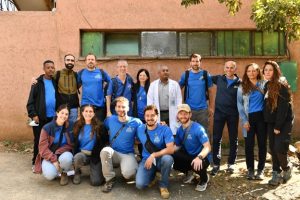
According to historians, animal husbandry and farming in Ethiopia have been practiced for more than 7thousand years. In the modern era the three successive governments have tried to implement various mechanisms to improve productivity and to some extent better outcomes are registered.
Nevertheless the sector has remained subsistence and vulnerable to natural calamities.
The recent report from government office shows that almost 95 percent of farmers have only less than 2 hectares land and due to population pressure the shrinkage of land size negatively affects productivity.
Furthermore, the ongoing climate change and global warming also exacerbates farmers’ uncertainties.
Tsedeke Abate (PhD) is a veteran agriculturalist. He has been working in various local and international organizations for the last 40 years. Recently, when he was a guest lecturer in a public debate platform organized by the Ethiopian Science Academy. He reflected his thought with regard to the status of subsistence farming and solutions that must be taken to turnaround things.
As to him, since the Emperor Haile Selassie’s era measures have been taken to improve the sector. But the measures were not utilizing the ideas of intellectuals as an input .Rather they were imposed by top-down approach. Hence, methods should be changed as per the demands of the time.
Currently, the rapid population growth can be said a major problem which could strangulate the sector. The continued plowing of small scale farming, including on steep slopes or hills, results in soil and natural resource depletion which in turn hampers productivity.
The dwindling of natural resources and biodiversity has made the matter worse. It is clear that the problems that arise from the sector are more structural rather than technical .This indicates that, solutions must be forwarded in an integrated approach.
The population census that was conducted in 1950 indicated that the then number of population in Ethiopia was 19 million. But now by the year 2019 the number of population has risen to 110 million. It is predicted that by 2050 the number will shoot up to 191 million.
Here the question is that, how we could feed such bulky number of population by the sector which is still found in a primordial level.
Hard work is needed to provide basic needs of the rapidly growing population through enhancing production, productivity and rehabilitation the already fragile ecosystem.
The increment of the number of population relied on farm made the land to be fragmented.That reduced the land size on average from 2.8 hectare to 0 .44 hectare. The volumes of crops that could be supplied as raw materials to local industries and to export markets have declined due to reduction of land size.
The importation of agricultural products for utilization as input to the local food industries is unacceptable and unaffordable.Hence, satisfying the local demand by local products should be a must.
In fact, as compared to other African countries maize productivity per hectare is rising next to South Africa. However, some pose a question that how could productivity be realized in such a small fragmented plots.
According to the recent Ministry of Agriculture’s report, nation widely on the average farmers have 0.91 hectare of land. But the export sector which relies on agricultural products indicates another picture. Since 2005 the graph of the sector’s performance has grown upward .
From 1996 to 2016 it did display growth by 14 percent annually but soon the importation goods debt rose by 17 percent.
The contribution of coffee to the export earning, depends on the volume of the trade and the earned dollar out of it. In the recent past the volume of the exported coffee has tumbled down by 33 percent. And in terms of price in 2016 it suffered a lapse by 14 percent which made the situation worrisome.
The export trade on soybeans since 2004 is improved. Its contribution to the economic growth is increased. Whereas, the volume of the Nigger export in 2016 has fallen by 30 percent as compared to the year 2014. On the other hand, the diversification of export of agricultural products is encouraging. In addition to the traditional export items such as coffee, the emerging products such as cereals, oil seeds, fruits and animal byproducts boost the nation hard currency earning capacity.
From 1992 to 1996, the contribution of coffee to the total agricultural products was 80 percent but from 2012 to 2016 its contribution was reduced by 30 percent.
Looking the situation in different angle, it shows the diversification of export products and its healthy and innovative aspects.
Recently, the volume of fruit export has increased by 20 percent which can be taken as a positive development. On the other hand, when it comes to oil seeds, except sesame the rest have plummeted both in terms of price and volume.
During the 1970s and 80s, due to the impact of drought other developing countries gave emphasis to promoting the cultivation of plants. At that time, Ethiopia neglected these crops which have comparative advantages in export earnings. This way sunflower and cabbage seeds are totally ignored.
While coffee is indigenous to Ethiopia , currently and ironically countries such as Brazil and Vietnam are earning billions of dollars from world coffee market. This clearly indicates how we are lagging far behind in enhancing export earnings from the coffee market.
These days, while the volume of export has made a nose dive, the import volume has increased. That forces the display a negative trade balance.
Currently, Ethiopia annually earns 556 million USD from oil seed products export but this amount of money never covers the import bill the nation spends for purchasing edible oil which is 588 million dollar.
In general, the nation agricultural export is struggling to support the nation’s currency earning and to boost it, a lot has to be done. Paradoxically, currently only 5 percent loan from financial institutions goes to the sector.
Among the agriculture researchers, only 7.2 percents are PHD holders and 40 percent with MA degree and 45 percent with BA and with such capacity the sector could go nowhere. Hence, to change the picture bold measures should be taken by the government and stakeholders.
The Ethiopian Herald Sunday Edition 12 January 2020
BY ABEBE WOLDE GIORGIS





